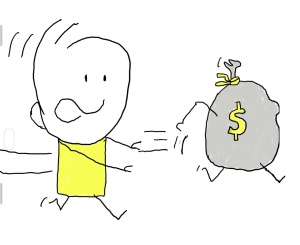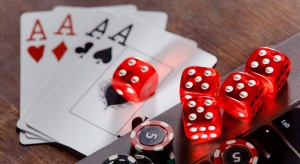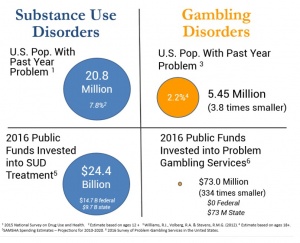Overview
If you are anything like me, you don’t see the point in gambling. You see that you are risking a lot with minimal chance of winning big. Around 6-9% of young adults experience problems related to gambling. Gambling becomes an addiction once a person starts to compulsively gamble, even when it takes a toll on your life. Compulsive gambling is a serious condition that can destroy lives.

Symptoms
A person might be a compulsive gambler if they are preoccupied with how to get more gambling money, needing to gamble with increasing amounts to get the same thrill, try to cut back and are unsuccessful, or they gamble to escape problems in their life. Unlike most casual gamblers who stop when losing or set a loss limit, people with a compulsive gambling problem are compelled to keep playing to recover their money; a pattern that becomes increasingly destructive over time (Mayo Foundation et al., 2016).

Biological similarities between substance abuse and compulsive gambling
Pathological gamblers generally have lower levels of norepinephrine than normal gamblers. Furthermore, norepinephrine is secreted under stress, arousal, or thrill, so pathological gamblers gamble to make up for their under dosage. It was also found during MRI and fMRIs that, “Monetary reward in a gambling-like experiment produces brain activation very similar to that observed in a cocaine addict receiving an infusion of cocaine (Jazaeri et al., 2012).

Comparing substance abuse and compulsive gambling
Compulsive gambling is described as “persistent and recurrent maladaptive gambling behavior,” similar to the description for substance dependence and abuse (Jazaeri et al., 2012). One of the key components to categorize substance abuse is withdrawal. One of the criteria for compulsive gambling is a need to gamble with increasing amounts of money to achieve the desired excitement. This is an example of “tolerance” in gambling. Furthermore, substance abuse includes a persistent desire or unsuccessful efforts to cut down or control substance use. Similar in compulsive gambling, a person may desire to cut down on the amount they gamble, but may find themselves unsuccessful (Jazaeri et al., 2012).
Treatments
There are a few ways to treat compulsive gambling including, therapy, medications, and self-help groups. Therapy can include behavioral or cognitive therapy. Behavior therapy uses systematic exposure to the behavior you want to unlearn and teaches you skills to reduce your urge to gamble. Cognitive behavioral therapy focuses on identifying unhealthy, irrational and negative beliefs and replacing them with healthy, positive ones. For medications, antidepressants and mood stabilizers may help problems that often go along with compulsive gambling such as depression, OCD or ADHD. Narcotic antagonists, which are useful in treating substance abuse, may help treat compulsive gambling (Mayo Foundation et al., 2016).
Conclusion
Although I may not understand the desire some people may have to gamble, it is clear that this is a serious disorder that some people cannot control. It is important to recognize if someone you know might be a compulsive gambler so you can reach out to them and help. If you currently are like me and do not gamble, you should probably keep it that way.
Works cited
Jazaeri, S. A., & Habil, M. H. (2012). Reviewing two types of addiction − pathological gambling and substance use. Indian Journal of Psychological Medicine, 34(1), 5–11. https://doi.org/10.4103/0253-7176.96147
Mayo Foundation for Medical Education and Research. (2016, October 22). Compulsive gambling. Mayo Clinic. Retrieved from https://www.mayoclinic.org/diseases-conditions/compulsive-gambling/symptoms-causes/syc-20355178.